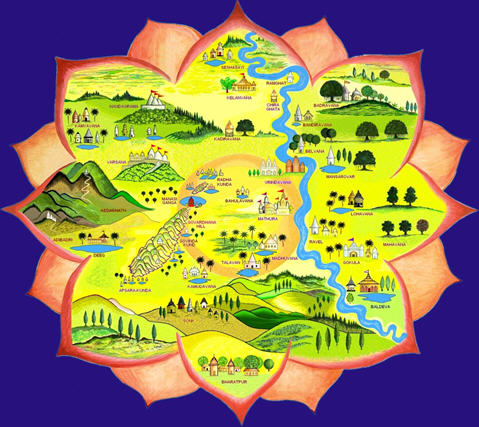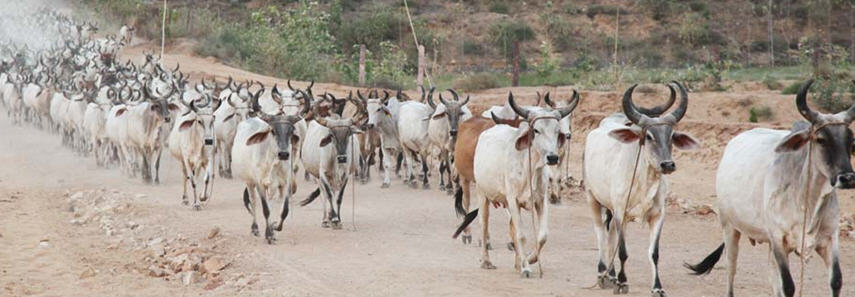
O #Govardhana, O king of mountains, O hill whose nectarian name the best of Hari’s servants flows from the moonlike mouth of Sri Radha,O hill that the Vedas declare to be the tilaka marking of Vraja, please grant me a residence near to you.
Govardhana Hill is acknowledged throughout the Vedic scripture’s as the most sacred mountain not only in the whole of India, but in all the three worlds. It is therefore no wonder that when Govardhana Hill appeared, all the great mountains of the universe came and worshiped him as their king. They also declared that Govardhana had descended from Goloka Vrndavana in the spiritual world and is the crown jewel of Vraja.
The Vedas also inform us that Govardhana Hill is understood in two different ways. First, as the greatest devotee of Lord Krsna, and second as being non-different from Lord Krsna Himself.
Before the beautiful gopis of Vrndavana, Srimati Radharani praised Govardhana Hill as the very best servant (Haridasa-varya) of Lord Krsna in the following words:
Of all the devotees, this Govardhana Hill is the best! O my friends, this hill supplies Krsna and Balarama, along with their calves, cows and cowherd friends, with all kinds of necessities – water for drinking, very soft grass, caves, fruits, flowers and vegetables. In this way the hill offers respects to the Lord.Being touched by the lotus feet of Krsna and Balarama,Govardhana Hill appears very jubilant.
Srimad-Bhagavatam 10.21.18: As the best servant, Govardhana Hill provides Krsna, Balarama and the inhabitants of Vrndavana with all the necessities of life. Cool fragrant drinking water from its many waterfalls, pure honey, mango juice and pilu juice, wonderful varieties of herbs, roots, fruits, creepers and fresh flowers. Govardhana also provides various minerals and precious gems that the cowherd boys use to decorate Krsna, Balarama alongwith themselves.
This sacred hill also provides deep caves where Krsna and Balarama rest and take shelter against the rain and the scorching sun. Krsna also enjoys many intimate loving pastimes with Srimati Radharani in these same caves.
Govardhana Hill also provides a special kind of soft, fragrant grass that makes the cows strong and healthy. This grass also helps increase the cow’s milk production, which is used to make pure ghee for the sacrificial fire and cooking. The milk is also turned into butter, yogurt, cheese and an amazing variety of milksweets.

Considering that milk is the economic backbone of the inhabitants of Vrndavana, it is no wonder that Lord Krsna advised the Vrajavasis to stop the sacrifice to Lord Indra and worship Govardhana Hill instead.
Govardhana Hill also provides Lord Krsna with a stage to perform His innumerable transcendental loving pastimes with the beautiful damsels of Vraja and with His many cowherd boyfriends.
The Vedas also say that Govardhana Hill is non-different from the Supreme Personality of Godhead, Lord Krsna Himself. When Sri Caitanya Mahaprabhu visited Vraja in the year 1515, He refused to climb Govardhana Hill because He saw that Govardhana was non-different from Lord Krsna. At the time of the annakuta ceremony, Krsna declared that He was non-different from Govardhana Hill:
Krsna then assumed an unprecedented huge form to instill faith in the cowherd men declaring, `I am Govardhana Mountain!’ He ate the abundant offerings. Together with the people of Vraja, the Lord bowed down to Govardhana Hill, thus in effect offering obeisances to Himself Then He said, ” Just see how this hill has appeared in person and bestowed mercy upon us!
Srimad-Bhagavatam 10.24.35-6 Because Govardhana Hill is non-different from Krsna Himself, the rocks from Govardhana are worshipable just like a Deity of Krsna, In fact, the stones known as Govardhana-silas do not even need to be installed as they are already considered to be worshipable. Many great devotees have worshiped these silas from Govardhana Hill. These devotees include Sanatana Gosvami and Raghunatha dasa Gosvami, as well as Lord Caitanya Mahaprabhu Himself.
Govardhana Hill should be envisioned to be in the shape of a peacock resting with its head tucked into its side. The peacocks face is considered to be the beautiful Kusuma-sarovara, its neck is Manasi ganga, its mouth Mukharavinda. In Govinda lilamrita Krishna Dasa Kaviraja Goswami says its two eyes are Radha-kunda and Syama-kunda it’s ears Gvala Pokhara, the beginning of its tail is Balarama Sthali, and the end of its tail is Punchari-kunda (Naval-kunda).
Appearance
Lord Krishna’s father Nanda Maharaja once enquired from his brother Upananda how Govardhana hill had appeared in the sacred land of Vrindavana. Upananda replied that King Pandu, father of the Pandavas, had asked this very question to Grandfather Bhishma, was had narrates the following story from the Garga Samhita:
One day in Goloka Vrindavana Lord Krishna informed Srimati Radharani that She should now appear on earth as it was time for Them to perform Their transcendental pastimes within the material world. Radharani replied that unless Vraja Dhama, the Yamuna and Govardhana Hill were present there, She would not be very happy. Krsna then told Radharani that She need not worry as Vraja Dhama, along with the Yamuna and Govardhana Hill had already appeared on earth.
Many years before this incident, in the land of Shalmali dvipa, the wife of the great mountain Dronacal gave birth to a son named Govardhana. At the time of Govardhana’s birth all the demigods appeared in the sky and showered flowers upon him. The great mountains, led by the Himalayas and Sumeru, came there to offer their respects. They then performed parikrama of Govardhana and accepted him as their king. They offered very nice prayers praising Govardhana for having descended from Goloka Vrindavana, describing him as the “crown jewel of Vraja.”
Some years later, at the beginning of Satya-yuga, the great sage Pulastya Muni paid a visit to Shalmali dvipa. Upon seeing the beautiful Govardhana Hill covered with many lovely creepers, flowers, rivers, caves and chirping birds, the sage felt that this hill was capable of giving liberation. He then went to meet Dronacal, who immediately offered his respects and inquired from the sage what service he could render.
Pulastya Muni informed Dronacal that he was from Kashi (Benares) and was on pilgrimage to all the Holy places. And he said that even though the sacred river Ganges flows through Kashi, there is no beautiful hill. He then asked Dronacal to give Govardhana to him so that he could perform his austerities sitting on top of the hill.
On hearing the sage’s request, Dronacal, who was not willing to part with his son, started to shed tears in thought of separation from his beloved Govardhana. Not wanting to see Pulastya Muni become angry and curse his father, Govardhana asked the sage how he would carry him all the way to Kashi. The sage replied that he would carry him in his right hand. Govardhana then agreed to go with the sage on one condition that if the sage put him down anywhere during the course of the journey, he would not be able to lift him again. Pulastya Muni agreed. Carrying Govardhana in his right hand he left for Kashi.
By the will of providence Pulastya Muni passed through Vraja on his way to Kashi. On arriving in Vraja, Govardhana thought that now he was here he should remain in the Holy dhama. By his mystic power he was able to influence Pulastya Muni to attend to the call of nature. Unmindful, the sage put Govardhana down and went off to answer the call. But when he returned he was unable to lift Govardhana again. Trying with all his might, using both hands, he could not lift Govardhana even slightly.
In great anger Pulastya Muni then became angry and cursed Govardhana to sink into the ground by the measurement of one mustard seed every day. When Govardhana first came to Vraja in the beginning of Satya-yuga, it is said that Govardhana at that time was 115 km (64 miles) long, 72 km (40 miles) wide and 29 km (16 miles) high. Now the hill is only 80 feet high at its highest point. It is said that after ten thousand years of the Kali-yuga Govardhana will have completely disappeared. It is said by Acaryas that Govardhana is decreasing in size because of separation from Lord Krishna.
After narrating the wonderful story of Govardhana’s appearance, Sunanda informed Nanda Maharaja that as long as Govardhana Hill and the river Yamuna remained manifest, Kali-yuga would not take its full effect. Sunanda also said that anyone who is fortunate enough to hear the description of the appearance of Govardhana Hill would be freed from all sins.
Another story about Govardhana dill is that the monkey army of Lord Rama was carrying different stones to construct a bridge to Lanka. This happened in Treta Yuga, when Lord Rama was getting ready to attack Lanka. Hanuman was carrying Govardhana from the Himalayas to help built the bridge. This was on the fifth day of construction. As Hanuman was carrying Govardhana over Braja, Nala and Neela, who were in charge of building the bridge declared that it was completed and no more stones were needed. When Hanuman heard this, he was in Braja Mandala and he placed Govardhana there. Govardhana then starting crying that he was lost in two ways. Now he was taken away from being close to Lord Siva, who lives in the Himalayas and he would not be able to be used in the service of Lord Rama and therefore, be able to see Him. Rama heard about Govardhana crying and said that in Dwapara Yuga he would be born as Sri Krishna and would hold Govardhana up for seven days and nights to save the residents of Braja.

Post view 562 times


